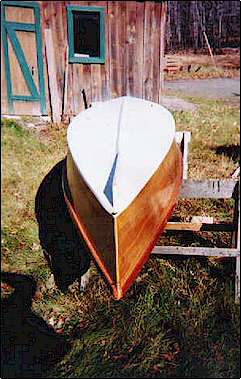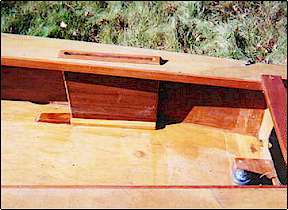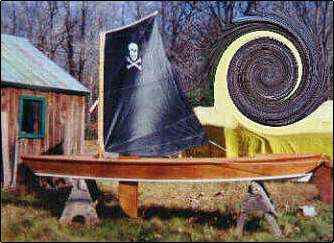|
Building The CSD Pirogue
by David M Galvin - galvind@wpe.com
| I built the Bolger Pirogue a few years ago, hoping
for an easily built, but stylish, cartopper that could be propelled
by various means: sail, oars, paddles, even a small outboard if
desired. My main intention was to execute the design in a way
that would allow it to be finished bright. |
| To that end I altered the construction somewhat, because, as
designed, the clear finish would have revealed much plywood end grain and crude joinery. |
 |
The plywood I used was ordinary lumberyard luan
underlayment (with exterior glue), which I carefully selected from the stack for grain and
color matching. |
| As might be noted in the photographs,
the deck and bottom are of a lighter shade than the hull sides. I assembled the side
panels with fiberglass butt joints on the inside. |
| The outside of the panels and joints were
grain-matched and coated overall with 6 oz. fiberglass and epoxy. |
 |
The keel shoe,
stems, and incidental framing was cut to plan from clear southern yellow pine. |
 |
The cockpit coamings, gunwales and chine logs were
cut 1/4" narrow in the athwartships dimension, installed, and the bottom and deck
were fitted over them. The joints between the deck panels are grain matched and S-shaped
"fashion" joints that do not show up well either on the photographs or on the
boat itself. After installing the deck and bottom panels, I glassed them and then fitted
1/4" thick strips of black walnut to the exposed edges of the coamings, gunwales and
chines. The deck framing of the daggerboard slot, as well as the mast step and thwart,
rudder cheeks daggerboard cheeks, outer stems, oar outriggers and deck peak joints are
also walnut. |
| I left out about a foot of flotation from either end of the
boat to allow the space to be used for storage. |
| The daggerboard was also my own innovation, as I
didn't like Bolger's leeboard idea. It is the same shape as the designed leeboard and sets
just inboard of the designed leeboard position. The daggerboard trunk was installed
along with the deck framing after I had fitted the bottom panel. |
 |
| The spares and sail are to plan.I sewed the sail out of black
3.5 oz. Dacron from a Sailrite kit. |

Swirl compliments of David's daughter, Sera
|
The Jolly Roger on the sail was cut from self
adhesive insignia cloth. All deck and sail hardware is bronze. The rowing seat is a
white pine box fitted with brass hardware salvaged from a rattan steamer trunk. The rudder
is to plan, and is a pain in the butt in that it doesn't stow in the boat easily. |
| After one season of use, I painted the bottom and chines, as
the varnish did not stand up to the abrasion and abuse in these areas. The spars are clear
white pine. All lines are from 1/4" Dacron. As built, the boat functions well when
sailed, rowed or paddled. |
I have never tried it with an
outboard, but I am sure that it would work fine with 1-2 hp on a canoe-type outboard
mount. However, at more than 100 lbs., the thing is simply too heavy for me to cartop. |

|
| Of course, it cannot be portaged either, which further limits
its use. If I were to build to this design again, I would make every effort to reduce the
weight, even at the expense of producing a cruder-looking vessel. It functions so well in
the water that it is a shame that I can't get it into the water more often, |

|